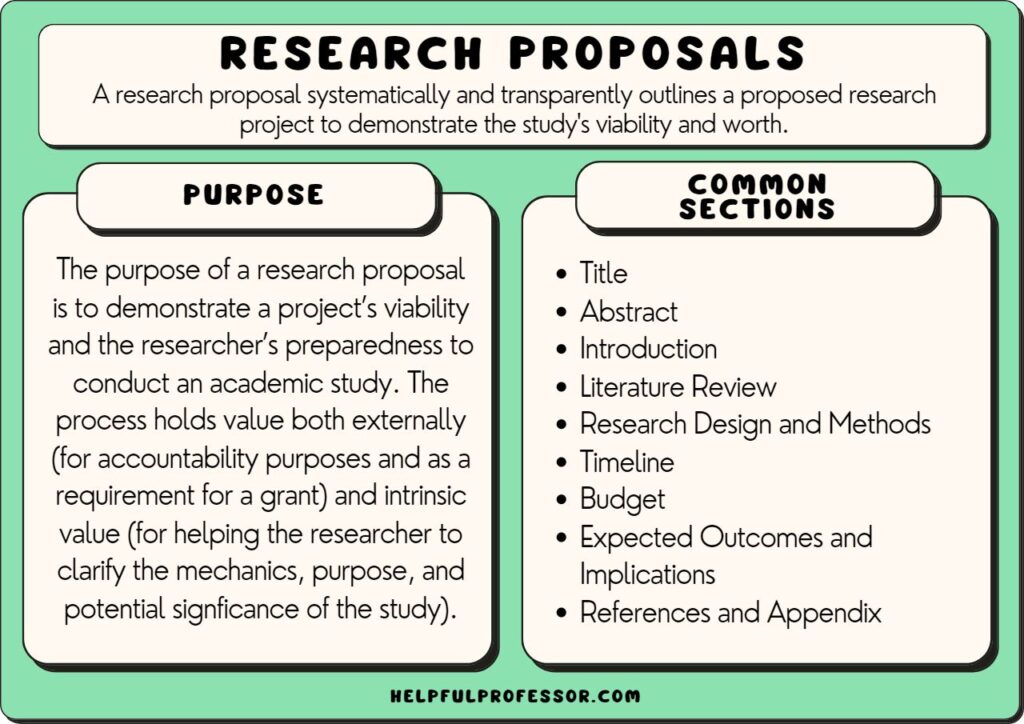

Written by Chris Drew (PhD)

Dr. Chris Drew is the founder of the Helpful Professor. He holds a PhD in education and has published over 20 articles in scholarly journals. He is the former editor of the Journal of Learning Development in Higher Education. [Image Descriptor: Photo of Chris]
| January 12, 2024
A research proposal systematically and transparently outlines a proposed research project.
The purpose of a research proposal is to demonstrate a project’s viability and the researcher’s preparedness to conduct an academic study. It serves as a roadmap for the researcher.
The process holds value both externally (for accountability purposes and often as a requirement for a grant application) and intrinsic value (for helping the researcher to clarify the mechanics, purpose, and potential signficance of the study).
Key sections of a research proposal include: the title, abstract, introduction, literature review, research design and methods, timeline, budget, outcomes and implications, references, and appendix. Each is briefly explained below.
Watch my Guide: How to Write a Research Proposal
Title: The title should present a concise and descriptive statement that clearly conveys the core idea of the research projects. Make it as specific as possible. The reader should immediately be able to grasp the core idea of the intended research project. Often, the title is left too vague and does not help give an understanding of what exactly the study looks at.
Abstract: Abstracts are usually around 250-300 words and provide an overview of what is to follow – including the research problem, objectives, methods, expected outcomes, and significance of the study. Use it as a roadmap and ensure that, if the abstract is the only thing someone reads, they’ll get a good fly-by of what will be discussed in the peice.
Introduction: Introductions are all about contextualization. They often set the background information with a statement of the problem. At the end of the introduction, the reader should understand what the rationale for the study truly is. I like to see the research questions or hypotheses included in the introduction and I like to get a good understanding of what the significance of the research will be. It’s often easiest to write the introduction last
Literature Review: The literature review dives deep into the existing literature on the topic, demosntrating your thorough understanding of the existing literature including themes, strengths, weaknesses, and gaps in the literature. It serves both to demonstrate your knowledge of the field and, to demonstrate how the proposed study will fit alongside the literature on the topic. A good literature review concludes by clearly demonstrating how your research will contribute something new and innovative to the conversation in the literature.
Research Design and Methods: This section needs to clearly demonstrate how the data will be gathered and analyzed in a systematic and academically sound manner. Here, you need to demonstrate that the conclusions of your research will be both valid and reliable. Common points discussed in the research design and methods section include highlighting the research paradigm, methodologies, intended population or sample to be studied, data collection techniques, and data analysis procedures. Toward the end of this section, you are encouraged to also address ethical considerations and limitations of the research process, but also to explain why you chose your research design and how you are mitigating the identified risks and limitations.
Timeline: Provide an outline of the anticipated timeline for the study. Break it down into its various stages (including data collection, data analysis, and report writing). The goal of this section is firstly to establish a reasonable breakdown of steps for you to follow and secondly to demonstrate to the assessors that your project is practicable and feasible.
Budget: Estimate the costs associated with the research project and include evidence for your estimations. Typical costs include staffing costs, equipment, travel, and data collection tools. When applying for a scholarship, the budget should demonstrate that you are being responsible with your expensive and that your funding application is reasonable.
Expected Outcomes and Implications: A discussion of the anticipated findings or results of the research, as well as the potential contributions to the existing knowledge, theory, or practice in the field. This section should also address the potential impact of the research on relevant stakeholders and any broader implications for policy or practice.
References: A complete list of all the sources cited in the research proposal, formatted according to the required citation style. This demonstrates the researcher’s familiarity with the relevant literature and ensures proper attribution of ideas and information.
Appendices (if applicable): Any additional materials, such as questionnaires, interview guides, or consent forms, that provide further information or support for the research proposal. These materials should be included as appendices at the end of the document.
Research proposals often extend anywhere between 2,000 and 15,000 words in length. The following snippets are samples designed to briefly demonstrate what might be discussed in each section.
See some real sample pieces: